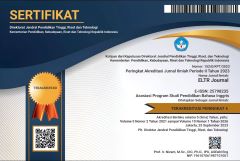A STUDY OF FILLERS UTTERED IN ENGLISH PUBLIC SPEAKING
DOI:
https://doi.org/10.37147/eltr.v3i2.98Keywords:
public speaking, fillers, utterancesAbstract
In the formal context of communication, capability to speak in public and convince the audiences becomes an essential necessity (Al-Tamimi, 2014). Nevertheless, many people are afraid of public speaking (Brewer, 2001). As a result, fillers such as err…, umm…, or well, so, you know, I mean are often produced. However, fillers are considered as additional utterances produced by speakers to communicate naturally with the listeners. They help the speakers to shift one idea to another to make the listeners understand the meaning conveyed by the speakers easily. This study investigated twenty English public speaking videos and looked for the variation of fillers uttered by the speakers. The results showed that so, err, and umm were the frequent fillers uttered. The use of these fillers had various functions such as to introduce the speaker’ ideas, to gain audience’s attention, or to give time for the speakers to search for the word.
Downloads
References
Al-Tamimi, N. M. (2014). Public speaking instruction: abridge to improve English speaking competence and reducing communication apprehension. International Journal of Linguistics and Communication, 2(4), 45-68.
Baalen, I.V. (2001). Male and Female Language: Growing together?.Retrieved November 30, 2017.Fromhttp://www.let.leideuhiv.nI/hsl_shl/VanBaalen.htm.
Bogdan, R., & Biklen, S. K. (2007). Qualitative research for education: An introduction to theories and methods (5th ed.). New York: Pearson Education, Inc.
Brewer, H. (2001). Ten steps to success. Journal of Staff Development, 22(1), 30-31.
Brown, H. D. (2007). Teaching by principles: An interactive approach to language pedagogy (3rd ed.). New York: Pearson Education, Inc.
Bygate, M. (1987). Speaking. Oxford: Oxford University Press.
Corley, M., & Hartsuiker, R. (2011). Why um helps auditory word recognition: The temporal delay hypothesis. PLoS One, 6(5). Retrieved from e19792.10.1371/ journal.pone.0019792.
Crystal, D. (2003). English as a global language (2nd ed.). Cambridge: Cambridge University Press.
Dalton, P., & Hardcastle, W. (1977). Disorders of fluency. London: Edward Arnold.
Du Bois, J. W. (1974). Syntax in mid-sentence. Barkeley studies in syntax and semantics, 1(3), 1-25.
Filipi, A., & Wales, R. (2003). Differential uses of okay, right, and alright, and their function in signaling perspective shift or maintenance in a map task. Semiotica, 47, 429-455.
Garcés Conejos, P. and Bou Franch, P. (2002). A Pragmatic Account of Listenership: Implications from Foreign/Second Language Teaching. Revista Alicantina de Estudios Ingleses, 15, 81-102.
Greene, J. O., & Cappela, J. N. (1986). Cognition and talk: The relationship of semantic units to temporal patterns of fluency in spontaneous speech. Language and Speech, 29, 141-157.
Grice, G., & Skinner, J. F. (1995). Mastering public speaking (2nd ed.). Massachusetts: Allyn and Bacon.
Gryc, J. (2014). Fillers in academic spoken English. Published bachelor’s thesis. Masaryk University, Czech Republic.
Jay, T. B. (2003). The psychology of language. New Jersey: Prentice Hall.
Laserna, C., Seih, Y., & Pennebaker, J. (2014). Um ... who like says you know: Filler word use as a function of age, fender, and personality. Journal of Language and Social Psychology, 33(3), 328-338.
Mukti, N. I., & Wahyudi, R. (2015). EFL students’ uses of um as filers in classroom presentations. Journal of Language and Communication, 2(1), 63-76.
Nippold, M. A.,Hesketh, L. J., Duthie, J.K.,&Mansfield, T.C. (2005). Conversational versus expository discourse: A study of syntactic development in children, adolescents, and adults. Journal of Speech, Language, and Hearing Research, 48, 1048-1064.
Pamolango, V. A. (2016). An Analysis of the Fillers Used by Asian Students in Busan, South Korea: A Comparative Study. International Journal of Languages, Literature and Linguistics, 2(3), 96-99.
Pamolango, V. A. (2015). Types and functions of fillers used by the female teacher and lecturer in Surabaya. Parafrase, 15(01), 11-15.
Rose, C. S., & Nilsen, K. (2013). Communicating professionally: A how-to-do-it manual (3rd ed.). Chicago: Neal-Schuman.
Rose, R. L. (1998). The communicative value of filled pauses in spontaneous speech. Published master’s thesis, University of Birmingham, Birmingham, United Kingdom.
Santos, N. M. B., & Alarcón, M. M. H. (2016). Fillers and the development of oral strategic competence in foreign language learning. Porta Linguarium, 25, 191- 201.
Schachter, S., Christenfeld, N., Ravina, B., & Bilous, F. (1991). Speech disfluency and the structure of knowledge. Journal of Personality and Social Psychology, 60, 362-367.
Schacter, S., Rauscher, F., Christenfeld, N., & Crone, K.T. (1994). The vocabularies of academia. Psychological Science, 5, 37-41.
Scott, C. M., & Windsor, J. (2000). General language performance measures in spoken and written narrative and expository discourse of school-age children with language learning disabilities. Journal of Speech, Language, and Hearing Research, 43, 324-339.
Starks, H. & Trinidad, S. B. (2007). Choose your method: A comparison of phenomenology, discourse analysis, and grounded theory. Qualitative Health Research, 17(10), 1372-1380.
Strenstrom, A. (2014). An introduction to spoken introduction. New York: Routledge.
Stenström, A. B. (1994). An introduction to spoken interaction. London: Longman.
Templeton, M., & Fitzgerald, S. S. (1999). Schaum’s quick guide to great presentations. New York: McGraw-Hill.
Wood, L. A. & Kroger, R. O. (2000). Doing discourse analysis. Thousand Oaks, CA: Sage Publications.
Yule, G. (2006). The study of language. Cambridge: Cambridge University Press.
Downloads
Published
How to Cite
Issue
Section
License
Copyright (c) 2019 Maryska Firiady, Aloisius Wisnu Mahendra

This work is licensed under a Creative Commons Attribution-ShareAlike 4.0 International License.













